
Welcome to Hyperion Records, an independent British classical label devoted to presenting high-quality recordings of music of all styles and from all periods from the twelfth century to the twenty-first.
Hyperion offers both CDs, and downloads in a number of formats. The site is also available in several languages.
Please use the dropdown buttons to set your preferred options, or use the checkbox to accept the defaults.

from notes by Leslie Howard © 1996
extrait des notes rédigées par Leslie Howard © 1996
Français: Hypérion
aus dem Begleittext von Leslie Howard © 1996
Deutsch: Hypérion
 Frederic Lamond - The complete Liszt recordings, HMV/Electrola 1919-36 Frederic Lamond - The complete Liszt recordings, HMV/Electrola 1919-36‘I suggest you look in this particular disc for something of Lamond’s greatness’ (MusicWeb International)» More |
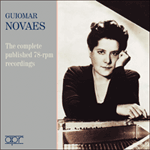 Guiomar Novaes - The complete published 78-rpm recordings Guiomar Novaes - The complete published 78-rpm recordingsThis double album draws together for the first time all the published 78-rpm recordings made by Brazilian Guiomar Novaes. She is better known today for her later recordings from the LP era, but these early miniatures, recorded between 1919 and 194 ...» More |
 Liszt: Complete Piano Music Liszt: Complete Piano MusicLeslie Howard’s recordings of Liszt’s complete piano music, on 99 CDs, is one of the monumental achievements in the history of recorded music. Remarkable as much for its musicological research and scholarly rigour as for Howard’s Herculean piano p ...» More |
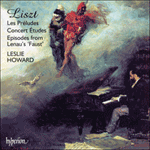 Liszt: The complete music for solo piano, Vol. 38 - Les Préludes Liszt: The complete music for solo piano, Vol. 38 - Les Préludes‘A rewarding collection, very well played and recorded’ (The Penguin Guide to Compact Discs) 'Prueba evidente del absoluto dominio y comprensión musical que posee el intérprete de la obra del compositor hungaro' (CD Compact, Spain)» More |
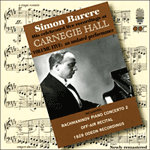 Simon Barere – His celebrated live recordings at Carnegie Hall, Vol. 5 - Rachmaninov's Piano Concerto No 2 & appendices Simon Barere – His celebrated live recordings at Carnegie Hall, Vol. 5 - Rachmaninov's Piano Concerto No 2 & appendices'The fifth and final volume of Simon Barere’s live Carnegie Hall performances includes a fascinating, typically vertiginous performance of Rachmaninov ...» More |
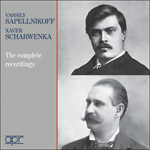 Vassily Sapellnikoff & Xaver Scharwenka - The complete recordings Vassily Sapellnikoff & Xaver Scharwenka - The complete recordingsVassily Sapellnikoff (1868–1941) and Xaver Scharwenka (1850–1924) were among the earliest generation of pianists to record, and on this ground alone it is surprising that their complete recordings have never before been transferred for modern list ...» More |
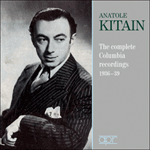 Anatole Kitain - The complete Columbia recordings, 1936-39 Anatole Kitain - The complete Columbia recordings, 1936-39Anatole Kitain (1903–1980) was an exact contemporary and fellow pupil of Vladimir Horowitz in Kiev, where he studied, as did the slightly older Simon Barere, with Felix Blumenfeld. All three developed fabulous techniques and were romantic pianists ...» More |
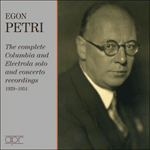 Egon Petri - The complete Columbia and Electrola solo and concerto recordings Egon Petri - The complete Columbia and Electrola solo and concerto recordingsEgon Petri (1881-1962) studied with Busoni and was perhaps his greatest disciple. In his fusion of intellect with an astonishing virtuoso technique he echoed his master and gives us today the clearest idea of Busoni’s own legendary pianism.» More |
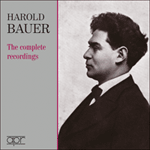 Harold Bauer - The complete recordings Harold Bauer - The complete recordings Gramophone» More Gramophone» More |
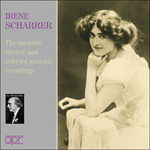 Irene Scharrer - The complete electric and selected acoustic recordings Irene Scharrer - The complete electric and selected acoustic recordings‘If [Irene Scharrer]'s remembered from her recordings it’s really only the one, and that was ironically the last she made, Litolff’s Scherzo from the ...» More |
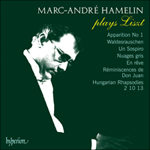 Liszt: Marc-André Hamelin plays Liszt Liszt: Marc-André Hamelin plays Liszt‘The virtuosity with which all this is despatched is exceptional’ (BBC Record Review) ‘There are few living pianists who can match him in dexterity, power and daring. For heart-thumping virtuosity Hamelin is in a class of his own’ (Clas ...» More |
 Louis Kentner – The pioneering Liszt recordings, Vol. 2 Louis Kentner – The pioneering Liszt recordings, Vol. 2'Excellently transferred from 78s dating from 1939-59, this selection ranges from Liszt’s early exuberance to the grim-faced austerity of his final ye ...  BBC Music Magazine» More BBC Music Magazine» More |
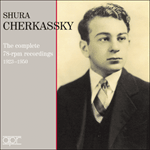 Shura Cherkassky - The complete 78-rpm recordings, 1923-1950 Shura Cherkassky - The complete 78-rpm recordings, 1923-1950In his later years, Shura Cherkassky (1909-1995) was regarded as one of the last ‘Romantics’—a throwback to the so-called ‘golden age’ of pianism in the first decades of the 20th century. As a pupil of Josef Hofmann, he had an impeccable pedigree, ...» More |
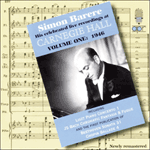 Simon Barere – His celebrated live recordings at Carnegie Hall, Vol. 1 - 1946 Simon Barere – His celebrated live recordings at Carnegie Hall, Vol. 1 - 1946 |
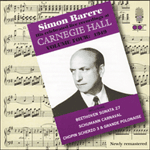 Simon Barere – His celebrated live recordings at Carnegie Hall, Vol. 4 - 1949 Simon Barere – His celebrated live recordings at Carnegie Hall, Vol. 4 - 1949 |
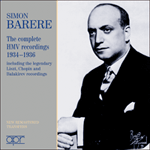 Simon Barere - The complete HMV recordings 1934–1936 Simon Barere - The complete HMV recordings 1934–1936 |
 Liszt: Piano Music Liszt: Piano Music |

